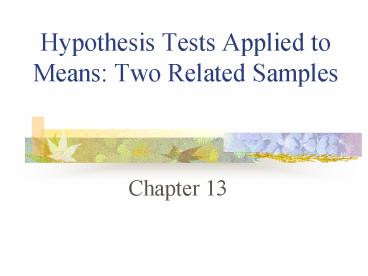Hypothesis Tests Applied to Means: Two Related Samples - PowerPoint PPT Presentation
1 / 13
Title:
Hypothesis Tests Applied to Means: Two Related Samples
Description:
In chapter 12, we tested if the mean of the one sample we drew was different ... the difference between the individual's performance on two occasions. D= x1 - x2 ... – PowerPoint PPT presentation
Number of Views:94
Avg rating:3.0/5.0
Title: Hypothesis Tests Applied to Means: Two Related Samples
1
Hypothesis Tests Applied to Means Two Related
Samples
- Chapter 13
2
Testing Means
- In chapter 12, we tested if the mean of the one
sample we drew was different from a population
mean - In this chapter, we will test for differences
between 2 sample means - Specifically, we will test the sample means from
samples that are related in some way
3
2 Related Samples
- Related samples (repeated measures, matched
samples) - An experimental design in which the same
individual is observed under more than 1
treatment (i.e. we collect data from an
individual more than once) - Ex we could record an individuals anxiety
levels both before and after an exam. We would
expect the 2 scores to be related. A highly
anxious individual will be so both before and
after the exam, but we will also expect the
scores to be different from time 1 and 2 - When we collect data from an individual more than
once, we are usually interested in changes in
that variable
4
2 Related Samples
- This is also the situation when the data from one
individual is related to the data from another
individual - Ex We would expect the marital satisfaction of
husbands and wives to be related - If we know something about one member of a pair
of scores, we also know something about the other
member of the pair (even if it is something small)
5
Example 1 Same Person
- We measure anxiety on a 10 point scale where 1 is
not at all and 10 is very. We do this both
BEFORE and AFTER an exam. Here are the scores - Before After
- Person 1 9 7
- Person 2 5 2
- Person 3 3 1
- Person 4 7 5
- Person 5 8
7
6
Example 2 Pairs of People
- We measure marital satisfaction on a 10 point
scale where 1 is not at all and 10 is very.
We do this with both HUSBANDS and WIVES. Here
are the scores - HUSBANDS WIVES
- Pair 1 5 3
- Pair 2 6 7
- Pair 3 1 2
- Pair 4 2 4
- Pair 5 8 10
7
Using Example 1
- Person 1 2 3 4 5
- Before 9 1 3 7 8 x15.6
- After 7 2 1 5 7 x24.4
- Diff. 2 -1 2 2 1
- Difference scores are the set of scores
representing the difference between the
individuals performance on two occasions - D x1 - x2
8
Difference Scores
- Once we have the D score for each person, we can
get the mean D score (D) - We sum up the D scores and divide by n
- We can also compute the variance and SD of the D
scores - For the variance (sD2)
- ?(D-D)2 / n
- For the SD (sD)
- Sqrt (sD2 )
9
Hypothesis testing
- When testing hypotheses using related samples
- The null hypothesis will be that there is no
difference between the scores or the population
of difference scores (?D) is 0 - H0 ?D ?Before - ?After 0
- The alternative hypothesis will be that there are
differences between the 2 sets of scores or that
on set is larger/smaller than the other - H1 ?Before ? ?After or ?D ? 0
10
The t statistic
- t (D - 0) / sD
- Where sD sD / sqrt(n)
- This is the standard error of the difference
- n the number of difference scores
- This is the same computation as the one sample
case, we are just substituting D for X - We use the t-tables in the same way as for the
one sample tests - The interpretation is that either there is or is
not a difference between the 2 sets of scores
11
Example
- In a study on attraction, people were asked to
rate pictures of people taken before and after
they had braces. Ratings of attractiveness are
given in the table. The researcher wants to know
if people differ in attractiveness after they
have had braces. - Picture Pre-Rating
Post-rating - 1 113
115 - 2 105
117 - 3 120
125 - 4 119
117 - 5 104
107 - 6 100
105 - 7 111
110
12
Advantages of Repeated Measures
- Avoid problem of individual differences (i.e.
variability from subject to subject) thus, giving
us more power by keeping sample variance small - Control for extraneous variables ex ask 5 people
anxiety before exam (10, 10, 10, 10, 10) and
another 5 people after (1, 1, 1, 1, 1) how do we
know that first 5 arent always anxious and
second always calm? - Requires fewer people because we have multiple
observations per individual
13
Disadvantages of Repeated Measures
- Order effect
- The effect of performance attributable to the
order in which treatments were administered - Ex. I have you run a mile, I measure your heart
rate, I have you study for 1 minute and then I
measure your heart rate. If I did this in reverse
order it would have a major impact on the data
collected - Carry-over effect
- The effect of previous trials (conditions) on a
subjects performance on subsequent trials - Ex I have you take an exam, 1 week later I give
you exam again. It is likely that seeing the
questions before will influence your performance































